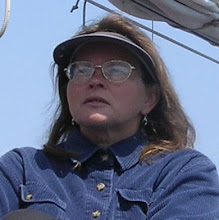
The push to save Swallowtail was helpful in kick-starting the Village Registry. It is hoped that this funding will continue so more of Grand Manan's historic places can be listed.


Norma also had an undated photo of herself on the boardwalk leading from the keepers house to the lighthouse. You can clearly see the detail in the windows that used to grace the lighthouse, removed to reduce maintenance and water leakage. The windows were single pane, 12 over 8. The porch covering the entrance to the lighthouse also no longer exists and when the soil was removed from around the lighthouse to remove lead from years of scrapping and painting the lighthouse, the soil level is significantly lower. There was concern that the lead in the soil was slowly leaching toward the coast and could one day end up in the ocean. The boardwalks no longer exist as well, although they were an original feature when the lighthouse was built in 1860. This extensive system of boardwalks would be a wonderful asset to rebuild, however, because of the wind and winter gales, maintenance of the boardwalks was a challenge with storm damage frequently occurring. They would have to be firmly attached. The style of the railings is similar to the existing railings on the footbridge.

